Happy holidays from The Arboretum at Penn State! Our skilled horticulture team, staff, and volunteers have been hard at work creating seasonal cheer. We encourage you to take a stroll through the gardens this winter season and take in our festive seasonal displays, complete with planted containers; decorated trees; fresh-cut evergreens; hand-made wreaths, ornaments, and creations; and lights! Holiday light displays will be on daily from 6:00–8:00 a.m. and nightly from 4:00–9:00 p.m. through early January. Visit our Seasonal Container Plant List page for a full list of what’s planted in our containers this season and learn more about a few of the species and varieties featured in this year’s displays below.
What’s on Display?
Abies fraseri (Fraser fir)
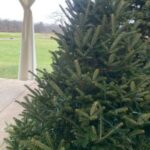 The Fraser fir is one of the most popular commercial Christmas tree choices available with its fragrant scent and sturdy branches that are capable of supporting heavy ornaments. This fir can grow up to 50 feet tall and features a conical shape with dark green/yellow flat needles that are white-banded underneath, growing on branches that angle slightly upward. The common name and specific epithet of this tree are named after the Scottish botanist who discovered it and introduced it to England. This fir is closely related to, and often mistaken for, balsam fir (Abies balsamea), with the primary difference lying in the bracts of the cones scales.
The Fraser fir is one of the most popular commercial Christmas tree choices available with its fragrant scent and sturdy branches that are capable of supporting heavy ornaments. This fir can grow up to 50 feet tall and features a conical shape with dark green/yellow flat needles that are white-banded underneath, growing on branches that angle slightly upward. The common name and specific epithet of this tree are named after the Scottish botanist who discovered it and introduced it to England. This fir is closely related to, and often mistaken for, balsam fir (Abies balsamea), with the primary difference lying in the bracts of the cones scales.
Calocedrus decurrens (incense cedar)
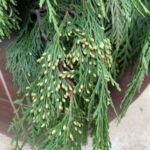 This aromatic evergreen conifer is native primarily to the Western United States and it is tolerant of heat and humidity. Incense cedar can grow to be anywhere from 30 to 150 feet, depending on habitat, and wild specimens can live to be over 1,000 years old! Medium-green foliage has an incense-like aroma when crushed, and the reddish-brown scaly bark is known to resist decay and insects. In fact, the pliable wood is often used as siding and window sashes and to make pencils. Wildlife mainly use this species for cover, but small mammals also eat the seeds. We think it makes a great cut green to use as filler in our winter containers!
This aromatic evergreen conifer is native primarily to the Western United States and it is tolerant of heat and humidity. Incense cedar can grow to be anywhere from 30 to 150 feet, depending on habitat, and wild specimens can live to be over 1,000 years old! Medium-green foliage has an incense-like aroma when crushed, and the reddish-brown scaly bark is known to resist decay and insects. In fact, the pliable wood is often used as siding and window sashes and to make pencils. Wildlife mainly use this species for cover, but small mammals also eat the seeds. We think it makes a great cut green to use as filler in our winter containers!
Chamaecyparis obtusa ‘Nana Gracilis’ (hinoki false cypress)
 Though it may not seem like it, this evergreen shorty from Japan can reach an eventual height of nine feet tall. ‘Nana Gracilis’ is a slow growing cultivar, popularly used for containers, rock gardens, and screens. Crush the foliage for a pleasing, quintessential winter fragrance.
Though it may not seem like it, this evergreen shorty from Japan can reach an eventual height of nine feet tall. ‘Nana Gracilis’ is a slow growing cultivar, popularly used for containers, rock gardens, and screens. Crush the foliage for a pleasing, quintessential winter fragrance.
Cornus sericea ‘Cardinal’ (red-osier dogwood)
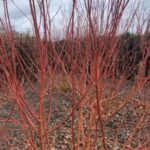 This is a native dogwood shrub with many wonderful attributes, including its popularity with the native wildlife. However, its winter ornamental display is probably most appreciated by humans. The brilliant red stems are left bare by late November, offering both structure and vibrancy to the landscape. To keep the color fresh for each cold season, prune the oldest stems back in early spring!
This is a native dogwood shrub with many wonderful attributes, including its popularity with the native wildlife. However, its winter ornamental display is probably most appreciated by humans. The brilliant red stems are left bare by late November, offering both structure and vibrancy to the landscape. To keep the color fresh for each cold season, prune the oldest stems back in early spring!
Cupressus arizonica var. glabra ‘Carolina Sapphire’ (Arizona cypress)
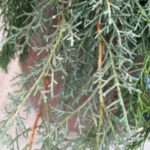 This medium-sized, broad and conical evergreen tree in the cypress family (Cupressaceae) can grow up to 60 feet tall and is native to the Southwestern United States. It is drought-tolerant and grows best in full sun and well-drained or sandy soil. Lacy foliage is slightly fragrant and comes in shades of silver-blue to teal with color staying bright all year round, providing seasonal interest in holiday displays as a cut green. It can also be used as a specimen tree, for screening, or for windbreaks.
This medium-sized, broad and conical evergreen tree in the cypress family (Cupressaceae) can grow up to 60 feet tall and is native to the Southwestern United States. It is drought-tolerant and grows best in full sun and well-drained or sandy soil. Lacy foliage is slightly fragrant and comes in shades of silver-blue to teal with color staying bright all year round, providing seasonal interest in holiday displays as a cut green. It can also be used as a specimen tree, for screening, or for windbreaks.
× Cuprocyparis leylandii (Leyland cypress)
 The Leyland cypress is a fast-growing evergreen hybrid. Its habit, foliage, and hardiness come from its nootka cypress (Chamaecyparis nootkatensis) parent while its rapid growth rate and branching come from its Monterey cypress (Cupressus macrocarpa) parent. Its flattened feathery sprays of leaves are grayish-green in color and grow upwards, creating a pyramidal shape. If you’re specifically looking for a Christmas tree or cut greenery without a fragrance, then this cypress may be for you!
The Leyland cypress is a fast-growing evergreen hybrid. Its habit, foliage, and hardiness come from its nootka cypress (Chamaecyparis nootkatensis) parent while its rapid growth rate and branching come from its Monterey cypress (Cupressus macrocarpa) parent. Its flattened feathery sprays of leaves are grayish-green in color and grow upwards, creating a pyramidal shape. If you’re specifically looking for a Christmas tree or cut greenery without a fragrance, then this cypress may be for you!
Ilex verticillata (winterberry)
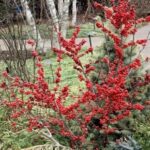 This eastern North American native holly, known as winterberry, is a deciduous shrub with toothed, dark-green leaves that often grows in swampy areas, thickets, and along ponds and streams. These plants are dioecious, meaning there are separate male and female plants. Thus, only females that have been fertilized properly will produce flowers in the spring that will result in the infamous bright red berries you may see in our Pollinator and Bird Garden and in our winter displays. It is estimated that only one male is necessary to fertilize 6–10 female plants. Berries will persist through the winter season into early spring.
This eastern North American native holly, known as winterberry, is a deciduous shrub with toothed, dark-green leaves that often grows in swampy areas, thickets, and along ponds and streams. These plants are dioecious, meaning there are separate male and female plants. Thus, only females that have been fertilized properly will produce flowers in the spring that will result in the infamous bright red berries you may see in our Pollinator and Bird Garden and in our winter displays. It is estimated that only one male is necessary to fertilize 6–10 female plants. Berries will persist through the winter season into early spring.
Juniperus procumbens ‘Nana’ (Japanese garden juniper)
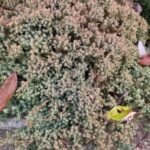 With a unique mat-forming and prostrate growing habit, this slow-growing juniper is a perfect “spiller” container component. ‘Nana’ is also a smart ground cover choice for dry soil landscapes, cascading beautifully over low walls and rocks. You may have also seen this variety as a bonsai; its compact form and branching habit are favorable traits for the art form.
With a unique mat-forming and prostrate growing habit, this slow-growing juniper is a perfect “spiller” container component. ‘Nana’ is also a smart ground cover choice for dry soil landscapes, cascading beautifully over low walls and rocks. You may have also seen this variety as a bonsai; its compact form and branching habit are favorable traits for the art form.
Juniperus virginiana ‘Grey Owl’ (eastern red cedar)
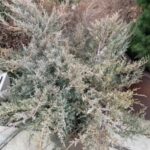 When planted in the landscape, ‘Grey Owl’ will spread to about six feet wide, doubling its height. The cool hue of its silvery-blue foliage is further enhanced when paired with warmer plant tones. When not growing in a container, this eastern red cedar enjoys blanketing slopes and serving as a strong foundation plant.
When planted in the landscape, ‘Grey Owl’ will spread to about six feet wide, doubling its height. The cool hue of its silvery-blue foliage is further enhanced when paired with warmer plant tones. When not growing in a container, this eastern red cedar enjoys blanketing slopes and serving as a strong foundation plant.
Picea pungens (Colorado blue spruce)
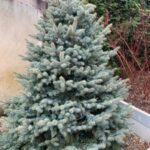 The blue spruce, also known as the Colorado blue spruce, is the state tree of Colorado and is another popular and recognizable Christmas tree, with its pyramidal shape and four-sided silver-blue needles which are sharper than fir tree needles. Spruce trees grow up to 75 feet tall in the mountainous regions of western and northern North America and feature downward-hanging cones that contrast their upward branches and needles. Be sure to also keep an eye out in the gardens for Picea pungens ‘Sester Dwarf,’ which is a dwarf form of blue spruce, requiring little pruning or maintenance to keep its shape. This variety is great in containers as it only grows to be about ¼ of the size of its larger parent!
The blue spruce, also known as the Colorado blue spruce, is the state tree of Colorado and is another popular and recognizable Christmas tree, with its pyramidal shape and four-sided silver-blue needles which are sharper than fir tree needles. Spruce trees grow up to 75 feet tall in the mountainous regions of western and northern North America and feature downward-hanging cones that contrast their upward branches and needles. Be sure to also keep an eye out in the gardens for Picea pungens ‘Sester Dwarf,’ which is a dwarf form of blue spruce, requiring little pruning or maintenance to keep its shape. This variety is great in containers as it only grows to be about ¼ of the size of its larger parent!
Pinus heldreichii (Bosnian pine)
 Bosnian pine is naturally illuminated with the glistening white fascicles (clusters) that bind each needle bundle together. This is an attractive, ornamental pine native to the Balkans, Italy, and Greece that prefers cooler summer climates and dryer soils.
Bosnian pine is naturally illuminated with the glistening white fascicles (clusters) that bind each needle bundle together. This is an attractive, ornamental pine native to the Balkans, Italy, and Greece that prefers cooler summer climates and dryer soils.
Pine trees may not be the most popular choice for Christmas trees, but some pines such as the Scotch pine and Eastern white pine are the species most commonly used. Unlike spruce and fir trees, pine trees have needles that grow in clusters and they are usually sparser, which allows for more space when decorating with larger ornaments.
Pinus mugo ‘Slowmound’ (mugo pine)
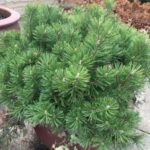 Mugo pine, also sometimes referred to as Swiss mountain pine, hails from the mountains of Central and Southern Europe. The cultivar ‘Slowmound’ is just what you may imagine — an extremely slow grower that provides a cushiony effect to the landscape. Tolerant of various soil types as well as salt, it is a great plant for coastal areas. Its slow growth rate and fine textured foliage make it a festive, container-friendly plant!
Mugo pine, also sometimes referred to as Swiss mountain pine, hails from the mountains of Central and Southern Europe. The cultivar ‘Slowmound’ is just what you may imagine — an extremely slow grower that provides a cushiony effect to the landscape. Tolerant of various soil types as well as salt, it is a great plant for coastal areas. Its slow growth rate and fine textured foliage make it a festive, container-friendly plant!
Thuja plicata ‘4EVER’ Forever Goldy® (western red cedar)
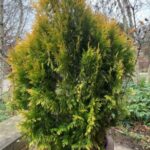 To brighten a dark garden corner, or for use in xeriscaping (landscaping with reduced irrigation in mind), Thuja plicata ‘4EVER’ Forever Goldy® is a great choice. This western red cedar cultivar’s golden foliage goes well with a wide variety of companion plants and its tolerance to drought makes it favorable for low maintenance and water-wise gardens.
To brighten a dark garden corner, or for use in xeriscaping (landscaping with reduced irrigation in mind), Thuja plicata ‘4EVER’ Forever Goldy® is a great choice. This western red cedar cultivar’s golden foliage goes well with a wide variety of companion plants and its tolerance to drought makes it favorable for low maintenance and water-wise gardens.
Thuja plicata ‘Grovepli’ Spring Grove® (western red cedar)
 This Thuja plicata cultivar is a popular go-to for those wanting a fast-growing and tall privacy screen. It boasts exceptional winter color (it maintains a bright glossy green in extremely cold temperatures), and its high resistance to deer browsing is just the star on the top. You may spot it throughout our winter displays or observe it planted as a large hedge near our front entrance.
This Thuja plicata cultivar is a popular go-to for those wanting a fast-growing and tall privacy screen. It boasts exceptional winter color (it maintains a bright glossy green in extremely cold temperatures), and its high resistance to deer browsing is just the star on the top. You may spot it throughout our winter displays or observe it planted as a large hedge near our front entrance.

